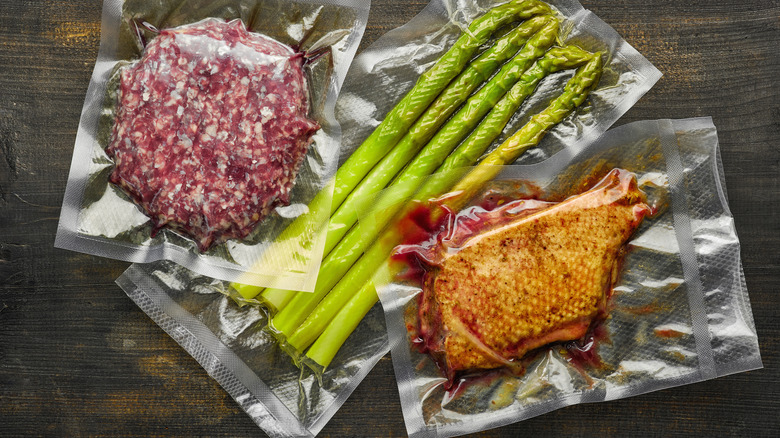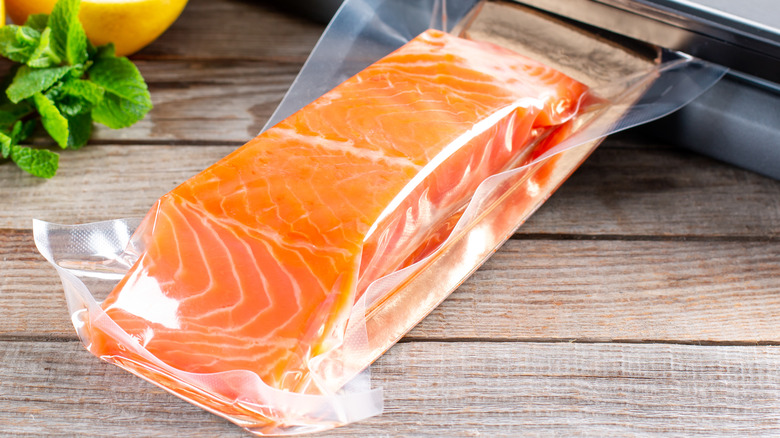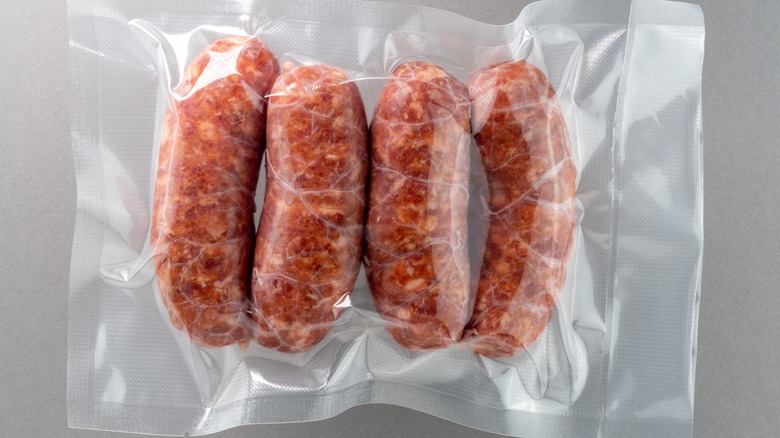The TikTok Vacuum-Sealing Food Hack You Absolutely Shouldn't Try
At some point in their life, every person will face the frustration that is spoiled food. We might put pints of strawberries, slabs of salmon, or crisp summer salads away in the fridge with the best intentions, but life gets in the way. Before we know it, these tempting foodstuffs have been reduced to slimy, moldy heaps of inedible gunk. The loss of something tasty stings badly enough on its own — the fact that it's a waste of money makes it all the more frustrating. When you toss ruined food away, you can practically hear the sound of hard-earned coins tinkling into the garbage can along with it.
Humanity has devised a number of ways to keep food fresh for longer amounts of time. We've been storing comestibles in dark, cool, underground spaces for thousands of years. Refrigerators brought such environments into every modern kitchen, courtesy of electricity. Airtight plastic containers made by companies like Tupperware keep everything from delicate berries to sturdy leftovers nice and fresh. Vacuum sealing ups the ante considerably by removing the air from a container entirely, dramatically restricting bacterial growth. Can this be accomplished without using a vacuum sealing machine? One TikTok user thinks so — but he's dangerously wrong.
A dangerous kitchen hack
TikTok user sidneyraz has racked up millions of followers with his handy life hacks. These range from his trick to untying plastic bags to efficient ways of peeling hard-boiled eggs. No one can deny the usefulness of such tips — but one of his recent videos touts a straight-up dangerous way of sealing food. In this short clip, sidneyraz demonstrates what he alleges is a cheap and easy way to vacuum seal food without using a vacuum sealing machine. He pours a container of blueberries into a Ziploc bag, then seals it up, leaving a tiny bit of space open at the very edge. He sticks a straw into this gap, seals his mouth around the straw's other end, and sucks the air out of the bag. Finally, he removes the straw and seals the bag entirely shut.
At first glance, this appears to be brilliant. The plastic bag pulls taut around the berries, just as it does when a proper vacuum sealing machine is used. It's also a remarkably quick process: He accomplishes it in under 30 seconds. Beyond everything, it's appealingly cheap — who doesn't have a straw and a Ziploc bag lying around? As vacuum sealers cost a pretty penny — the cheapest one recommended by New York Magazine is still a sizable $68 — it's easy to be drawn into this alleged life hack. But following this advice would be a major mistake.
Why DIY vacuum sealing is a bad idea
This deceptive hack seems like an incredible way to preserve just about anything. Sadly, it's simply too good to be true, and it all comes down to food safety. As the University of Minnesota details, even vacuum sealing with a machine requires a scrupulously clean workspace. When using such a gadget, they advise home cooks to wash their hands throughout the sealing process, refrain from touching the food directly, and make sure their work surface is nice and sanitized. If using a carefully calibrated machine that was specifically built to vacuum seal food requires this level of cleanliness, you can bet anything more DIY is a tremendous gamble that simply isn't worth taking.
The fact is, your mouth is full of germs. According to the National Institutes of Health, roughly 700 different kinds of microbes call the warm, wet hole in your face home. You simply can't sanitize it the way you can sanitize your hands. In fact, you wouldn't even want to — many of these marvelous microbes perform important functions. This means that using a straw to suck all the air out of your Ziploc bags is basically creating a canal that eager bacteria in your mouth can use to get to your bagged food. Nasty microbes might also make the jump from the food to your body, via the straw: As the CDC notes, dangerous bacteria like Salmonella, E. coli, and Yersinia can all be found in raw meat, produce, dairy products, and other foodstuffs. Bottom line: If you want to vacuum seal your food, buy a vacuum sealer.


